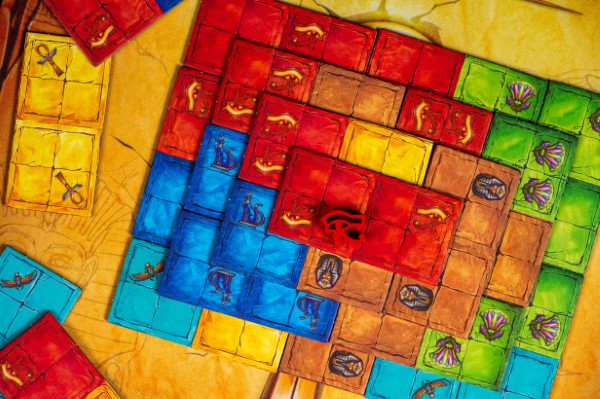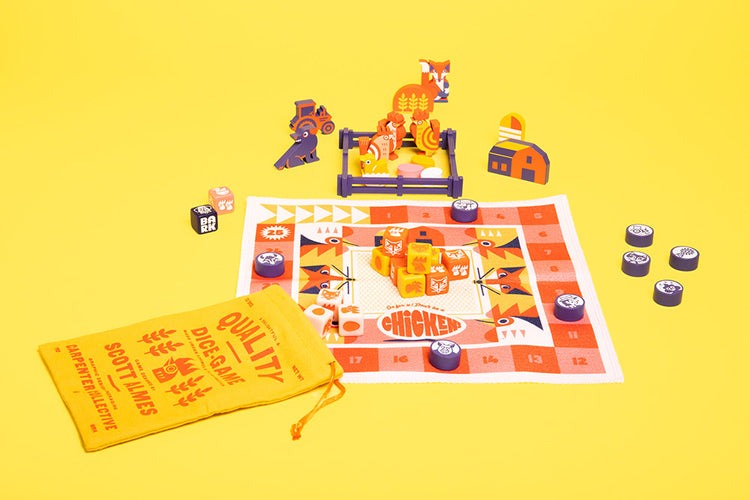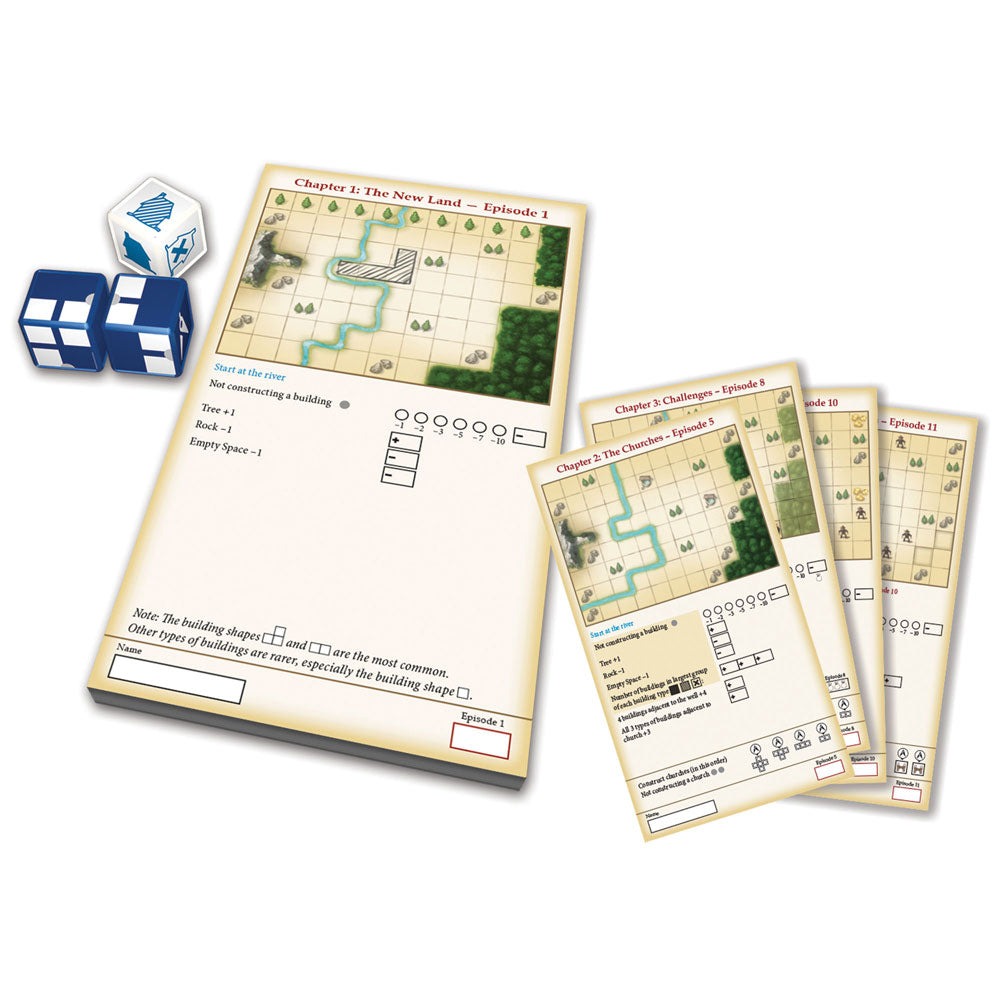Rapid Reviews: Pyramido, Chicken!, and My City: Roll and Build

This post contains affiliate links. If you use these links to buy something, we may earn a small commission. Thank you!
In this set of Rapid Reviews, we explore three thrilling new board games: Pyramido for strategic pyramid construction, Chicken! for fast-paced press-your-luck action, and My City: Roll and Build for city planning with dice. These games cater to various gaming preferences, offering strategic challenges and quick, engaging fun for your next gaming session.

Photo provided by the publisher
Pyramido
2-4 players | ages 8+ | 45 minutes
Designed by Ikhwas Kwon
Published by Synapses
Buy on Amazon
In a world where spatial puzzle games are getting more and more play, it’s hard to be noticed. And it’s likely the thinly themed Pyramido is going to get many glances at first. But it would be a mistake to discount this easy-to-learn but never-predictable game of domino tile stacking.
Play is simple, as each player is given 6 jewel markers and three double-sided resurfacing tiles, each matching the colors and symbols on the 90 2-by-1 tiles at hand. The game begins with the 90 tiles being shuffled and placed into 4 stacks (as evenly supplied as possible) and three randomly selected tiles being on display, one in between two adjacent stacks. The first player will draft a tile (often with two different colors and/or symbols on it) and place one of their matching jewel markers on the tile. If there are two colors and players still have both matching jewel markers, players may only choose one to place. After the tile is chosen, the player will replace the market with a tile from one of the two face-down stacks to its left or right, and then play continues to the next player.
During the first round, players will be constructing a 5x4 grid trying to group similar symbols and colors together, placing their jewel markers to be able to score the points of any matching symbols on the tiles. Players may use a resurfacing tile to either change the color of one side of the tile (to connect groups that may be broken up) or to fill in gaps based on how they build their pyramid. Once a tile is placed, it cannot be moved. Since players only have three resurfacing tiles, using them all and having more gaps to fill means they automatically lose the game. After everyone has completed their 5x4 grid (optimally using 10 tiles), they will add up the points of any connecting symbols that have a corresponding jewel marker placed on them. There is a bonus, as well, for each jewel marker with the least number of matching symbols, and this can be across multiple symbols. For example, if the scarab and eye of Horus both have 3 symbols, but the rest of the placed jewel markers have 4 symbols, players will gain a 2-point bonus on top of their scored points. Once scores are tallied, jewel markers are removed and players will begin to build on top of their base level with each subsequent round, with the same ability to play remaining resurfacing tiles to fill in gaps. As play progresses each round, fewer tiles will be used and building up shrinks by one length. Six tiles will be used in the second round, three in the third, and one in the fourth and final round.
However, as players build up, they’ll still want to connect colors and symbols to the lower levels, so placement of tiles is important to leave any symbols visible for as long as possible. Scoring in the second through fourth rounds will include symbols on the lower levels where colors are still connected, with the bonus also being in play. After the fourth round, each round’s total is added together with the highest total being the winner.
There’s something so simple in the rules of Pyramido, but its puzzle evolves with each play. The order tiles are available, what color/symbol combinations are best during that session, and how tiles are placed will always offer something new. It’s both a meditative and mind-bending experience to optimize play, and it’s best to save resurfacing tiles for when you need them (and to also note which colors/symbols are on each side so as not to cost oneself). Resurfacing tiles are powerful because they also allow players to play a second jewel marker during a turn if it’s available, so the longer you save the right one(s) until the last round, the better your score will be.
The right mix of strategy and simplicity, Pyramido is going to be great in collections of gamers who love the likes of Azul, Cascadia, and Evergreen. If it had a solo variant, it would be a great Sunday morning ritual for the chill early risers who like to do Sunday crossword puzzles.

Photo provided by the publisher
Chicken!
2-8 players | Ages 8+ | 10-20 minutes
Designed by Scott Almes
Published by Keymaster Games
Buy on Amazon
This aptly named push-your-luck dice chucker finds players risking it all in pursuit of points around the chicken coup. A player will begin by rolling the standard four white dice, setting aside any chickens or foxes that are displayed. The goal is to roll as many chicken faces as possible and avoid rolling three foxes. If a die has an egg showing, the player will gather a yellow die (if all yellow dice are in play, then players will gain orange dice equal to the number of eggs showing). The player will then decide to take points equal to the number of chickens showing, or to roll again with any dice that didn’t have a chicken or fox showing. If the player rolls three foxes, they bust and return any colored dice to the mat. If they don’t bust, they can collect their points and then transfer all the dice to the next player. The action continues in this manner until someone busts, which returns all but the four starting white dice to the coup. Players may also lose one point to remove the yellow and orange dice if they feel like the chances of getting three foxes is too great. The first player to reach 25 points is the winner.
Chicken! is a simple, easy-to-play game that has plenty of gristle in its decision space. As players accumulate more dice, they must decide: do they press their luck, or do they spend a point to be conservative? These are just some of the simpler decisions at hand. That said, Chicken! does suffer a bit at the three and six-player counts, as multiple playthroughs have found the third and sixth players are often stuck with a load of dice, not many points (if any) to spend to return dice, and players can quickly find themselves far enough behind on points that they decide the risk is necessary (thus removing some of the fun of the game’s decision space).
However, a game of Chicken! is so quick that it’s not hard to rotate the starting player for another game (and another, and another...). It’s perfect for car rides where the kids need some preoccupation, waiting at a restaurant for a table or some food, or other activities where having a 10-minute “distraction” turns that time into mindless fun.

Image provided by the publisher
My City: Roll and Build
1-6 players | Ages 10+ | 30 minutes
Designed by Reiner Knizia
Published by KOSMOS
Buy on Amazon
The follow-up to the original namesake, My City: Roll and Build transforms the polyomino placement and map management game into a portable roll-and-write experience. Players will be guided through four chapters, each composed of three episodes. These episodes will introduce new rules and parameters within which players must work to fill their maps with the polyomino buildings they roll.
These are determined by rolling two blue and one white dice. The white die represents the type of building, and the blue will be combined by lining up the gray dots to create the polyomino shape. The first building must often be constructed next to the river, but as the episodes progress, new rules may require players to begin elsewhere. Likewise, the compass on the blue dice becomes a factor in determining new building types that must be built. Other goals, such as connecting similar buildings together, corralling bandits, and covering plateau spaces become new point opportunities.
Players can also choose to not construct a building, which will increasingly cost them more and more points. Players can also choose to be done constructing at any point. Players will then add or subtract points based on the scoring parameters of each episode and determine their score. At the end of each chapter, they will add up the totals from all the episodes and determine the winner for that chapter. In the solo game, players are trying to score the most points based on a table of potential point outcomes.
My City: Roll and Build is both a leisurely-played and brain-burning game for players who like a good gaming puzzle. Situating the buildings around the map by the rules and scoring opportunities of each episode is a meditative challenge. Each game is quick, encouraging players to make it through entire chapters in one sitting. The way new rules are introduced never causes too much tension or stress and builds upon the mechanics and parameters introduced previously. By the time the final chapter occurs, players are well attuned to the challenge ahead to complete the game.




